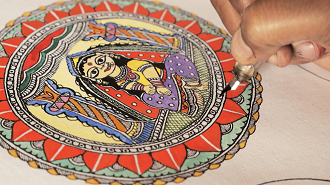
Sama in the Forest 2023
Distributed by Documentary Educational Resources, 108 Water Street, 5A, Watertown, MA 02472; 617-926-0491
Produced by Coralynn V. Davis
Directed by Carlos Gómez
Streaming, 75 mins
Middle School - General Adult
Storytelling; Women’s Rights
Date Entered: 05/08/2024
Reviewed by Kimberly Poppiti, St. Joseph's University, Patchogue, NYSama in the Forest focuses on the titular Indian story, and a related form of painting. The filmmakers also explore traditional and evolving family and gender norms within the culture of Madhubani, located in the state of Bihar, India, in which the film is set. This is a collaboratively created film grounded in the research of two women M.S. Suman (a writer) and Coralynn V. Davis (a professor and anthropologist). In creating this film, Suman and Davis worked with a community-based, collaborative filmmaker, Carlos C. Gómez, to document their experiences working with female storytellers, specifically those who have studied a traditional style of Indian storytelling through painting at Mithila Art Institute.
This film uses a traditional regional story, Sama in the Forest, to present an allegory for the lives of the region’s women, as well as to illustrate how the story can be told in performance and also through a series of paintings. Throughout the film, Gomez juxtaposes excerpts from interviews with community members, with footage from both an outdoor production of Sama in the Forest and a related “Sama Chakeva” festival, as well as with examples of the traditional artform of painting out this story as it is done by members of the community. Viewers can gain an understanding of the titular story and the painting style, as well as the basic elements of the Sama Chakeva festival, which is a nighttime event for women and children, in which clay figurines are created and used to enact Sama’s story.
Throughout the film, the storied experiences of the fictional Sama, a young woman and daughter of Lord Krishna, who is cursed by her father for venturing into the forest alone and befriending a man there, are paralleled with present-day experiences of the female members of the community who, like Sama, find their opportunities and freedom limited by the men in their lives.
As the film progresses, a correlation emerges between the oppression and abuse suffered by Sama in the story, and the treatment endured by many women in the present-day, including some of those featured in the film. Likewise, a connection also emerges between attendance at the Art Institute and increased self-confidence and autonomy among the women featured. These connections are commented on by male and female voices in the film, with the tension created by shifting ideas about the roles and rights of women palpably expressed. Toward the film’s conclusion, the sentiments of the male interviewees are juxtaposed with the ending of the story of Sama, and also with recent examples of women being cast out of their families, or even poisoned or hanged for perceived transgressions. Toward the film’s conclusion, it is noted that, while the women featured in the film are painting and also enacting the story of Sama in the Forest, the practice of storytelling in general is losing traction in the face of growing access to technology. Without the generational passing on of stories such as that of Sama in the Forest, not only are the stories and the artistic ways of telling them lost, but so are important accompanying life lessons.
Sama in the Forest documents a specific life experience of women living in a particular region of India, while also depicting the region’s unique forms of storytelling. It also explores gender roles and family relations, both historically and in the present day. There are brief accounts of violence against women, but no protracted or graphic violent or sexual content. In this way, the film is suitable for viewers of middle school age and up. It does, however, progress at a relatively slow pace and requires thoughtful viewing to connect the multiple interwoven elements to understand the sometimes-subtle presentation of themes and lessons. This film is worthwhile viewing, but due to its episodic structure and numerous featured characters and story elements, may be challenging for some viewers to track with. It is likely to be of greatest interest to those in the fields of Storytelling and Women’s Rights.
Awards:Society for Visual Anthropology Film and Media Festival "Best Feature Film" 2023
Published and licensed under the Creative Commons Attribution 4.0 license. Anyone can use these reviews, so long as they comply with the terms of the license.